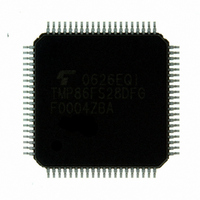TMP86FS28DFG(JZ) Toshiba, TMP86FS28DFG(JZ) Datasheet - Page 171

TMP86FS28DFG(JZ)
Manufacturer Part Number
TMP86FS28DFG(JZ)
Description
IC MCU 8BIT FLASH 60KB 80-LQFP
Manufacturer
Toshiba
Series
TLCS-870/Cr
Datasheet
1.TMP86FS28DFGJZ.pdf
(272 pages)
Specifications of TMP86FS28DFG(JZ)
Core Processor
870/C
Core Size
8-Bit
Speed
16MHz
Connectivity
SIO, UART/USART
Peripherals
LCD, PWM, WDT
Number Of I /o
62
Program Memory Size
60KB (60K x 8)
Program Memory Type
FLASH
Ram Size
2K x 8
Voltage - Supply (vcc/vdd)
2.7 V ~ 5.5 V
Data Converters
A/D 8x10b
Oscillator Type
Internal
Operating Temperature
-40°C ~ 85°C
Package / Case
80-LQFP
Processor Series
TLCS-870
Core
870/C
Data Bus Width
8 bit
Data Ram Size
2 KB
Interface Type
SIO, UART
Maximum Clock Frequency
16 MHz
Number Of Programmable I/os
62
Number Of Timers
6
Maximum Operating Temperature
+ 85 C
Mounting Style
SMD/SMT
Development Tools By Supplier
BM1040R0A, BMP86A100010A, BMP86A100010B, BMP86A200010B, BMP86A200020A, BMP86A300010A, BMP86A300020A, BMP86A300030A, SW89CN0-ZCC, SW00MN0-ZCC
Minimum Operating Temperature
- 40 C
On-chip Adc
10 bit, 8 Channel
For Use With
BM1401W0A-G - FLASH WRITER ON-BOARD PROGRAMTMP89C900XBG - EMULATION CHIP TMP89F LQFP
Lead Free Status / RoHS Status
Lead free / RoHS Compliant
Eeprom Size
-
Lead Free Status / Rohs Status
Details
Other names
TMP86FS28DFGJZ
Available stocks
Company
Part Number
Manufacturer
Quantity
Price
- Current page: 171 of 272
- Download datasheet (3Mb)
DBR
SIOCR1<SIOS>
SIOSR<SIOF>
SIOSR<SEF>
SCK pin
(Output)
SI pin
INTSIO Interrupt
11.6.3 8-bit transfer / receive mode
Figure 11-10 Receive Mode (Example: 8bit, 1word transfer, Internal clock)
to the data buffer registers (DBR). After that, enable the transmit/receive by setting SIOCR1<SIOS> to “1”.
When transmitting, the data are output from the SO pin at leading edges of the serial clock. When receiving,
the data are input to the SI pin at the trailing edges of the serial clock. When the all receive is enabled, 8-bit
data are transferred from the shift register to the data buffer register. An INTSIO interrupt is generated when
the number of data words specified with the SIOCR2<BUF> has been transferred. Usually, read the receive
data from the buffer register in the interrupt service. The data buffer register is used for both transmitting and
receiving; therefore, always write the data to be transmitted after reading the all received data.
are written. A wait will not be initiated if even one transfer data word has been written.
necessary to read the received data and write the data to be transmitted next before starting the next shift oper-
ation. When an external clock is used, the transfer speed is determined by the maximum delay between genera-
tion of an interrupt request and the received data are read and the data to be transmitted next are written.
The transmit/receive operation is ended by clearing SIOCR1<SIOS> to “0” or setting SIOCR1<SIOINH> to
“1” in INTSIO interrupt service program.
cleared, the transmitting/receiving is ended at the time that the final bit of the data has been transmitted.
SIOSR<SIOF> is cleared to “0” when the transmitting/receiving is ended.
cleared to “0”.
cleared to “0”, then SIOCR2<BUF> must be rewritten after confirming that SIOSR<SIOF> has been cleared to
“0”.
occurs after completion of transmit/receive operation, SIOCR2<BUF> must be rewritten before reading and
writing of the receive/transmit data.
After setting the SIO control register to the 8-bit transmit/receive mode, write the data to be transmitted first
When the internal clock is used, a wait is initiated until the received data are read and the next transfer data
When an external clock is used, the shift operation is synchronized with the external clock; therefore, it is
When SIOCR1<SIOS> is cleared, the current data are transferred to the buffer. After SIOCR1<SIOS>
When SIOCR1<SIOINH> is set, the transmit/receive operation is immediately ended and SIOSR<SIOF> is
If it is necessary to change the number of words in external clock operation, SIOCR1<SIOS> should be
If it is necessary to change the number of words in internal clock, during automatic-wait operation which
That the transmitting/receiving has ended can be determined from the status of SIOSR<SIOF>.
a
0
a
1
a
2
a
3
a
4
Page 159
a
5
a
6
a
7
Read out
a
b
0
b
1
b
2
Clear SIOS
b
3
b
4
b
5
TMP86FS28DFG
b
6
b
Read out
7
b
Related parts for TMP86FS28DFG(JZ)
Image
Part Number
Description
Manufacturer
Datasheet
Request
R
Part Number:
Description:
Toshiba Semiconductor [TOSHIBA IGBT Module Silicon N Channel IGBT]
Manufacturer:
TOSHIBA Semiconductor CORPORATION
Datasheet:
Part Number:
Description:
TOSHIBA GTR MODULE SILICON NPN TRIPLE DIFFUSED TYPE
Manufacturer:
TOSHIBA Semiconductor CORPORATION
Datasheet:
Part Number:
Description:
TOSHIBA GTR Module Silicon N Channel IGBT
Manufacturer:
TOSHIBA Semiconductor CORPORATION
Datasheet:
Part Number:
Description:
TOSHIBA Intelligent Power Module Silicon N Channel IGBT
Manufacturer:
TOSHIBA Semiconductor CORPORATION
Datasheet:
Part Number:
Description:
TOSHIBA INTELLIGENT POWER MODULE SILICON N CHANNEL LGBT
Manufacturer:
TOSHIBA Semiconductor CORPORATION
Datasheet:
Part Number:
Description:
TOSHIBA IGBT Module Silicon N Channel IGBT
Manufacturer:
TOSHIBA Semiconductor CORPORATION
Datasheet:
Part Number:
Description:
TOSHIBA GTR MODULE SILICON N−CHANNEL IGBT
Manufacturer:
TOSHIBA Semiconductor CORPORATION
Datasheet:
Part Number:
Description:
TOSHIBA Intelligent Power Module Silicon N Channel IGBT
Manufacturer:
TOSHIBA Semiconductor CORPORATION
Datasheet:
Part Number:
Description:
TOSHIBA GTR Module Silicon N Channel IGBT
Manufacturer:
TOSHIBA Semiconductor CORPORATION
Datasheet:
Part Number:
Description:
TOSHIBA INTELLIGENT POWER MODULE
Manufacturer:
TOSHIBA Semiconductor CORPORATION
Datasheet:
Part Number:
Description:
TOSHIBA Intelligent Power Module Silicon N Channel IGBT
Manufacturer:
TOSHIBA Semiconductor CORPORATION
Datasheet:
Part Number:
Description:
TOSHIBA Intelligent Power Module Silicon N Channel IGBT
Manufacturer:
TOSHIBA Semiconductor CORPORATION
Datasheet:
Part Number:
Description:
TOSHIBA IGBT Module Silicon N Channel IGBT
Manufacturer:
TOSHIBA Semiconductor CORPORATION
Datasheet:
Part Number:
Description:
TOSHIBA Intelligent Power Module Silicon N Channel IGBT
Manufacturer:
TOSHIBA Semiconductor CORPORATION
Datasheet:
Part Number:
Description:
Toshiba Semiconductor [SILICON N CHANNEL 1GBT]
Manufacturer:
TOSHIBA Semiconductor CORPORATION
Datasheet:











